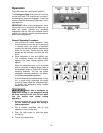
13
While performing the
following steps, keep the blade from rubbing
excessively on the shoulder of the wheel.
Excessive rubbing will damage the wheel
and/or the blade.
4. Start the saw. Turn the set screw (Figure
14) to tilt the idler wheel until the blade is
touching the shoulder of the idler wheel.
5. Turn the set screw (Figure 14) so the blade
starts to move away from the shoulder of
the wheel; then immediately turn the set
screw in the other direction so the blade
stops; then moves slowly towards the
shoulder. NOTE: This adjustment is
sensitive; do it gradually and in small
increments allowing the wheel to respond to
the changes.
Keep your fingers clear of
the blade and wheel to avoid injury.
6. Turn the set screw to stop the shifting of the
blade on the wheel as it gets closer to the
wheel shoulder. Put a six-inch length of
paper between the blade and the wheel.
See Figure 15. The paper should not be cut
as it passes between the wheel shoulder
and the blade.
7. Turn the set screw a small amount. Repeat
the insertion of the paper between the wheel
shoulder and the blade until the paper is cut
into two pieces.
NOTE: You may have to repeat the check
with the paper several times before the
blade and the shoulder cut the paper into
two pieces. Do not hurry the adjustment.
Patience and accuracy here will pay off with
better, more accurate, quieter cutting and
longer machine and blade life.
8. When the paper is cut, back off the set
screw slightly. This assures that the blade is
not touching the shoulder of the wheel.
IMPORTANT: If the blade is allowed to run
against the shoulder of the wheel, it will
wear off the shoulder.
Setting Blade Speed
Rotate the dial (see Figure 16) to the desired
setting – 135, 197 or 256 feet per minute.
Do not change blade speed
during a cutting operation.
Figure 14
Figure 15
Figure 16


















